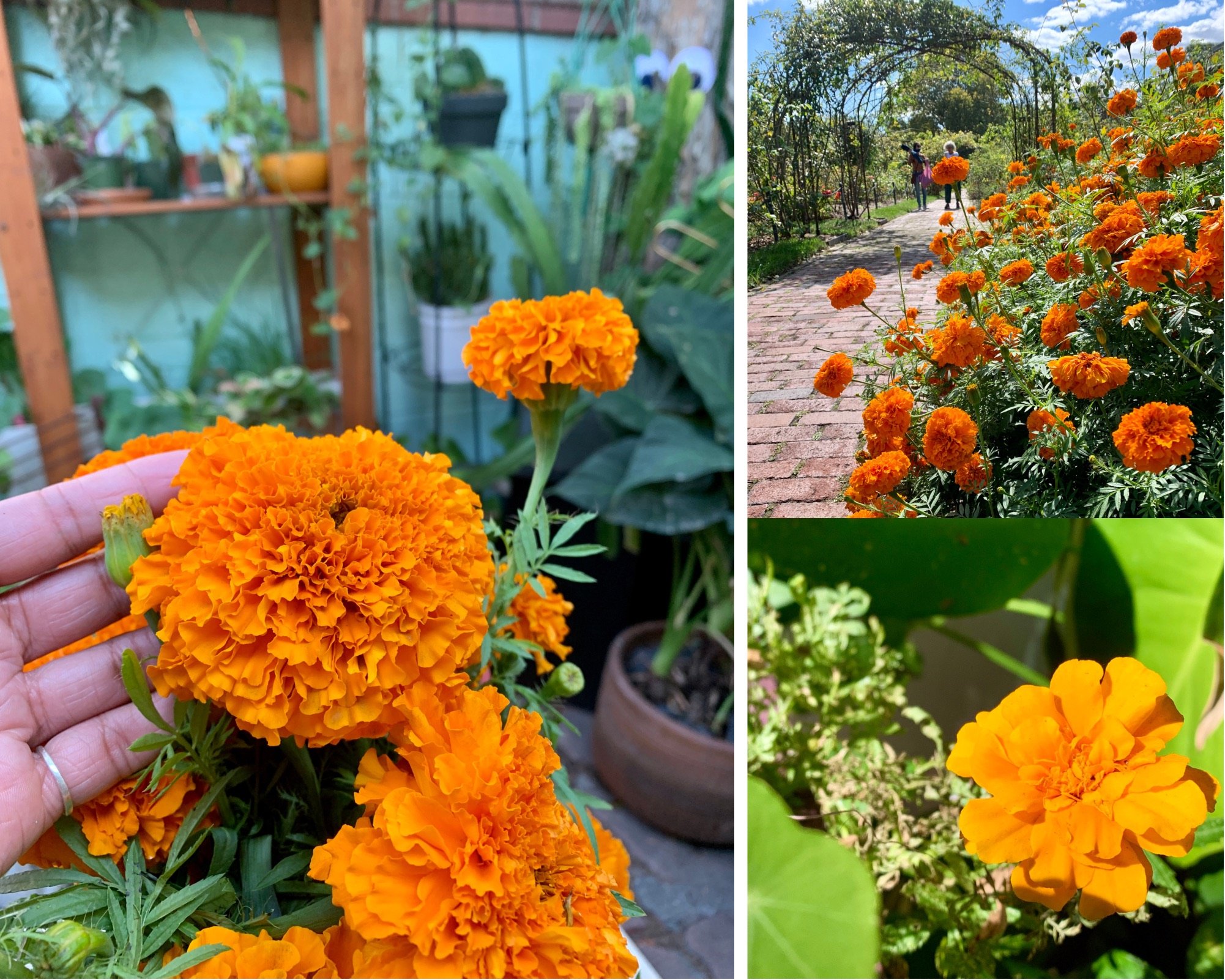Fall flowers: Which marigold is right for you?
28 Oct Fall flowers: Which marigold is right for you?
When we started cooking with edible blooms, marigold flowers were among of the first we learned we could eat. So…we ate some petals. Did we like the taste? Not really. (If you want some blossoms that actually taste like a fun peppery ingredient versus a garnish, grow some nasturtiums. The usual advisory about growing them yourself organically and watching out for harmful pesticides apply.) Marigolds came flashing back onto our radar last year in early- to mid-autumn when we saw their fluffiest incarnations being bought by the armful at the farmer’s market. We learned about marigolds warming the altars of loved ones for Día de los Muertos. The plant also known as cempasúchil was used by the Aztecs in medicines and feasts.
In late summer of this year, I planted some of the non-thick marigold flowers (French marigolds, Tagetes patula, native to Mexico and Guatemala despite its common name) on my patio in LA — in the window box typically reserved for edible flowers. The box also housed some nasturtium that had self-seeded and, against everyone’s advice about never planting mint with anything, mint. It’s this delectable-smelling lavender mint and we regret nothing.

In the LA garden: The round leaves are actually nasturtium. The blooms are French marigolds.

At the Brooklyn Botanic Garden in late September. Roses, what roses? We asked in the rose garden.

Marigolds were at the height of their power.
The box arrangement reminded us of the other thing we’d always heard about marigolds. That they are supposedly PEST-REPELLING MVPS. The aromatic foliage and stems of marigolds are reputed to repel cabbageworms, thrips, squash bugs, whiteflies, and mosquitos while attracting beneficial insects like hoverflies and ladybugs. We haven’t seen or done studies to support this but we can attest to the strong vegetal scent that might not be for everyone. We think the smell is perfectly fine and kind of interesting. It’s also deer resistant.
Then during a New York trip in September, my world was rocked by a mob of marigolds taking over the rose garden at the Brooklyn Botanic Garden. Back in LA in October, I wanted to find that thicker squishier kind I sweated at the farmer’s market, with flowers dense like the pom poms on a winter hat. Those ones are African marigolds aka Mexican marigolds aka Tagetes erecta, native to Mexico.


The bees were busy.
They were hard to find in orange but I managed to snag two of the last five-gallon potted plants of Tagetes erecta from Mickey Hargitay’s. There are about 50 species of marigolds, but these three you’re most likely to see and hear about:
- French marigolds (Tagetes patula) — 6 to 12 inches tall and 6 to 9 inches wide. Double flowerheads up to 2 inches across.
- African/Aztec/Mexican marigolds (Tagetes erecta) — the tallest variety of marigolds, up 1 to 4 feet tall and 1 to 2 feet wide. Densely double flowerheads can span up to 5 inches across.
- Signet marigold (Tagetes tenuifolia) — up to 12 inches tall and wide. Flowerheads are single and usually 1 inch in size. Unlike the bitter-tasting two species above, signet marigold flowers have a pleasant citrusy taste and are used on salads and other dishes.
(Source: Garden Design)

Yeah, that nursery pot says “Hold for Chantal.”


The full sun that marigolds need is scarce on the patio. A fix: hanging them via Smart Pots and macrame from a random bolt in the retaining wall. This extra lift translates into more light access and hopefully more blooms.
Here are some care tips for marigold plants:
(Speaking of healthy plants, we recently talked to Porch about how to know your plant is probably healthy.)
Sun: Full outdoor sun.
Seasonality: Flowers summer through fall. Most marigolds are annuals, but they self-seed so you might get plants next year without even trying.
Soil: Make it rich. We used Ocean Forest potting soil mixed with pumice for drainage, plus a generous layer of Bu’s Blend compost on top. Occasionally apply a diluted liquid fertilizer, making sure it’s not too nitrogen heavy (which leads to more foliage and fewer blooms).
Showiness: Pinch off spent blooms for a bushier display.
Water: At the base of the plant directly in the soil; try not to let the leaves or flowers get wet (to avoid the below). Water when the plant has dried out a little bit, more in times of drought.
Watch out for: Powdery mildew and flower bud rot in which young buds shrivel before blooming. There are ample ways to address these issues.
Fun fact: Farmers add marigolds to chicken feed to make the yolks a richer color.
—TH

Cut flowers from the farmer’s market, a gift from my dear friend Semra when she came to visit.


Happy marigold and googly-eyes-on-plants season to all who celebrate.






